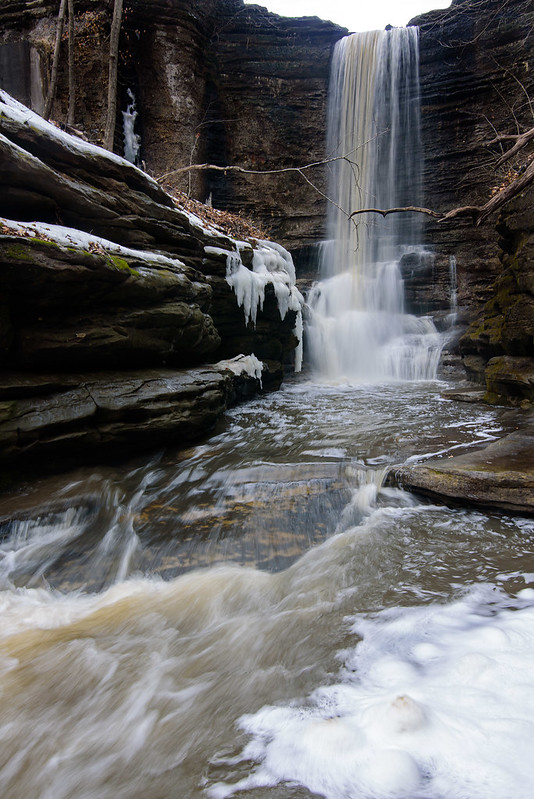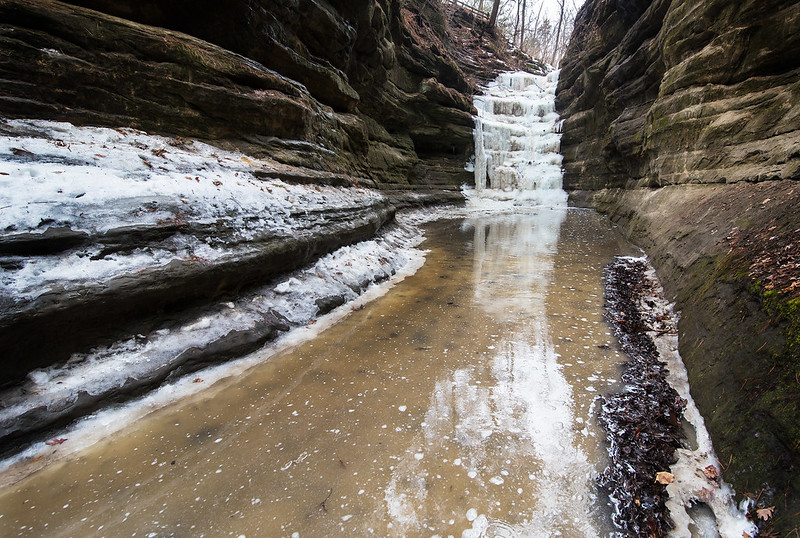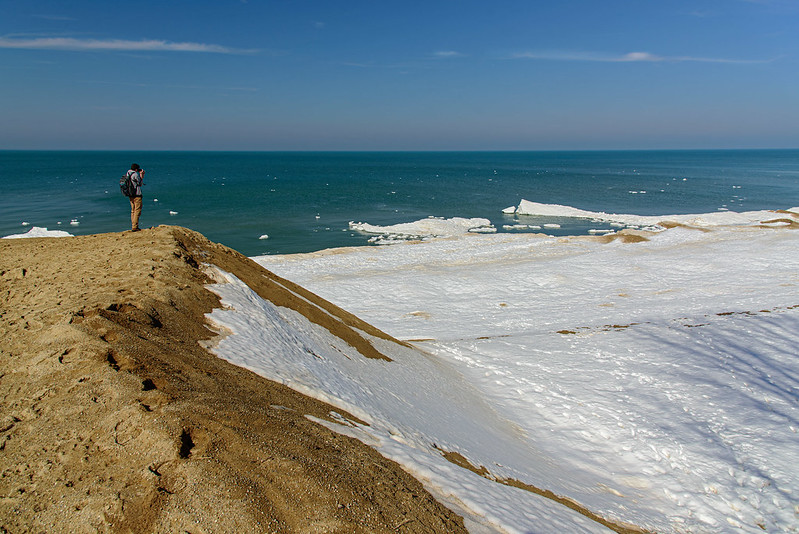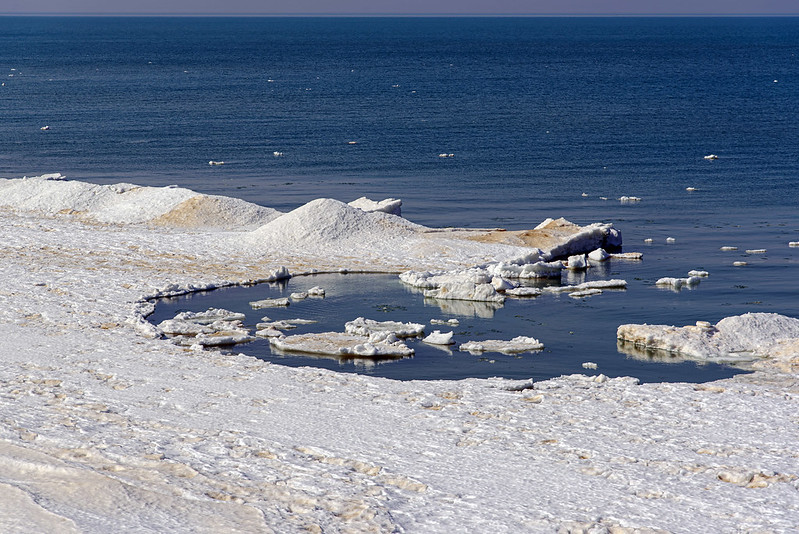I've changed the address of my photo blog. You should be automatically redirected, but if not here is the new address:
Lake Falls

A full wall of ice just days earlier, Lake Falls is flowing once again thanks to the large amount of meltwater flowing into the lake above the falls. Hiking through Illinois' Matthiessen State Park during winter yields quite a few frozen waterfalls -at least six. On this visit, they were in various stages of melting, some completely gone, and others, half way thawed. The melting increased the amount of water in the upper and lower dells, which in turn, destroyed more of the icefalls.
Not only is the ice melting, but to get to the frozen waterfalls is much more difficult if you wish to stay warm and dry. The paths for at least two of these falls were under at least a foot of flowing water. We decided to visit them anyway, and walked through the cold water; our feet were cold for about 10 minutes as the 35 degree water flooded our boots. But after that, they remained a rather comfortable temperature as our body heat warmed up the water in our boots. Even if our feet stayed cold, it was worth the effort to see these falls once again.
Not only is the ice melting, but to get to the frozen waterfalls is much more difficult if you wish to stay warm and dry. The paths for at least two of these falls were under at least a foot of flowing water. We decided to visit them anyway, and walked through the cold water; our feet were cold for about 10 minutes as the 35 degree water flooded our boots. But after that, they remained a rather comfortable temperature as our body heat warmed up the water in our boots. Even if our feet stayed cold, it was worth the effort to see these falls once again.
Generally Lake Falls is a bit more accessible, and flows a bit more gentle, but this time we couldn't get too close to the falls without getting ourselves and our gear sprayed with water. Many of the interesting logs that fell into the canyon have disappeared over the years; these were often covered in intricate ice formations, but no longer.
The stream is filled with small cascades of water most only a foot tall like the one in the foreground of the top image. These provide great elements in the landscape, and give so many possible compositions.
I hiked this time without my tripod, so these images, which were taken with a slow shutter of 1/6th of a second, were taken handheld with no support. Without a tripod, it gets a bit tricky to get sharp images at that speed.
Frozen French Canyon

Following a week of warm weather, we decided to visit Starved Rock State Park once again, before all of the frozen waterfalls were melted. On our last trip in the very cold weather, we visited the waterfalls that generally have the most intricate ice formations - knowing they would soon be gone. On this hike, we saw the melting icefalls that we figured would still be somewhat frozen, and we were right.
These waterfalls tend to stay frozen for a bit longer than the fragile falls in LaSalle Canyon because they're thicker and in more shaded canyons. French Canyon is one of those very shady locations and generally doesn't have a huge amount of water flowing into the canyon. A heavy flow of water quickly melts the ice formations, while a more gentle one cascades over, under, or around the ice.
These waterfalls tend to stay frozen for a bit longer than the fragile falls in LaSalle Canyon because they're thicker and in more shaded canyons. French Canyon is one of those very shady locations and generally doesn't have a huge amount of water flowing into the canyon. A heavy flow of water quickly melts the ice formations, while a more gentle one cascades over, under, or around the ice.
This canyon is generally a bit tricky to access when the stream is flowing (if you don't want wet feet), but in winter, it's extremely slippery and difficult to access. Park staff at the visitor's center have told us time and time again that it's not worth even trying to get into French Canyon in the winter - it's too dangerous. The stream flows directly on the portion of the canyon floor that is used for walking, so plenty of ice forms in this area. Without ice cleats on your boots, it's next to impossible to safely walk up into this canyon. Because we've been here many times before, we had our cleats with us.
In the photo above, you can see just how frozen the canyon floor was. No place to hold on to, so you absolutely need ice cleats, and even then, if there is snow on top of the ice, or if the cleats hit rock, you will still slide. I would hate to fall here, not only would you get wet, but you would probably continue sliding 30 or 40 feet down into the pool of water at the entrance to the canyon. I don't know how deep that water is, but you would certainly have a difficult time climbing out, and a very cold walk back to the car.
The recent high temperatures has created quite a bit of melt water, in fact, it flooded the canyon and kept us from walking too far in. We were already wet to the knees from walking through the stream at Matthiessen Park, but we weren't too certain how deep this water was, so it was best to keep out of the flooded canyon.
The melt water did allow for some very interesting colors and a nice reflection of the 40 foot tall frozen waterfall. This waterfall doesn't freefall into the canyon, it cascades over the stepped rock formations, so I think it's one of the more interesting waterfalls of the park.
Every day the warm weather eats away at the ice in all 18 canyons of Starved Rock, so if you hope to see some frozen waterfalls, it's best to visit very soon, or you will need to wait until next winter. Bring ice cleats even if you think the trails are clear - you will need them - sometimes into April.
Every day the warm weather eats away at the ice in all 18 canyons of Starved Rock, so if you hope to see some frozen waterfalls, it's best to visit very soon, or you will need to wait until next winter. Bring ice cleats even if you think the trails are clear - you will need them - sometimes into April.
The Thawing Shelf Ice
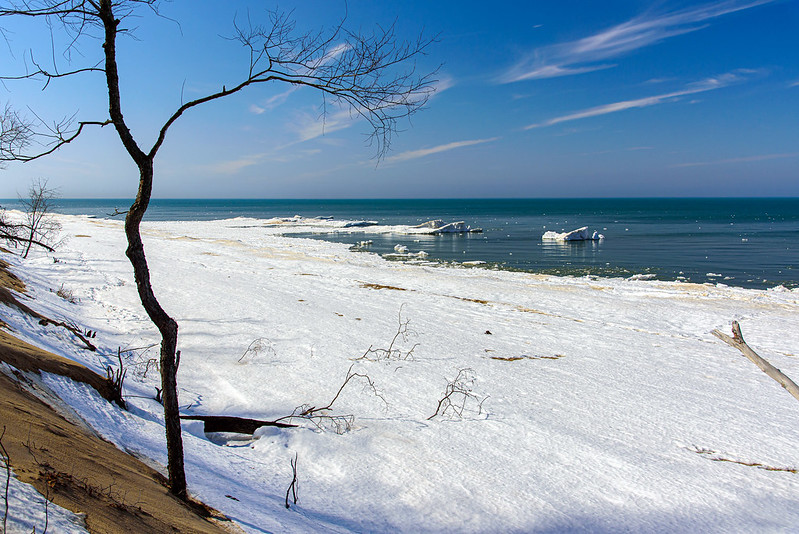
Just a few days earlier, Lake Michigan was filled with ice as far as the eye could see. Last week, we hiked through thigh-deep snow in this same spot to view the ice mounds on the beach, this week, they're almost gone. Only a couple of days of 40 degree weather and the floe ice melts quickly, and soon, all of this ice will be gone as well - it's meteorological spring already.
While our goal was to hike to Kintzele Ditch last week and this week, we approached from a different access this time - Central Beach. Closed for quite some time because of erosion and well water problems with the remodeled washrooms, it's a nice change to access the beach quickly via our old standby trails.
The remnant ice took on the look of the arctic, like small icebergs floating just off shore. But these mounds stood at the bottom of the lake and rose up a few feet above the water.
Some years, these ice mounds can rise 15 feet above the water - as high as the waves can throw the ice chunks when they pound the shore. This year didn't produce the usual number of mounds or ice volcanoes, but it was pretty none-the-less.
Just as it does when the ice forms, when it melts, it creates interesting structures on the beach. This cove is being enlarged little by little as the waves move floe ice into and out of the ice shelf. The beach was lined with similar structures as we hiked the shore to Kintzele Ditch, each unique in size and shape.
My only regret was not having our kayaks- it would be amazing paddling in and out of these small coves near the ice mounds. Maybe next year.
Subscribe to:
Posts (Atom)
